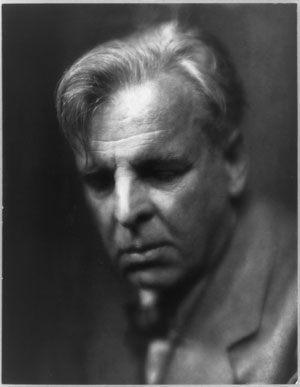|
Africans appear
in the same setting as that of Yeats’ poem, wearing ‘white’
dresses contrasting with their blackness, bringing to mind the
snow-white feet of Salley in Yeats’ poem. There is a sense of
mingling between the cultures of Africans and Europeans: 'To
the melodies of Europe/roll the rhythms of the Congo', and a
bringing together of the constructs of both cultures by this
juxtaposition: 'a marriage mixed/but a marriage still' (62).
The ultimate
expression of affinity appears in evocation of the persona’s
dead mother:
William Butler,
I swear my dead mother
embraced me. I
then washed off my heart
with the
amniotic water of a green coconut. (Turn Thanks 1999:
47)
Leaving out the
last name of Yeats while referring to this profound moment of
reconciliation with the memory of the dead mother, followed by
the quasi-ritual cleansing process with the sweet-tasting
water of a coconut, presents a supreme moment of amalgamation
of the two cultures. The fact that the coconut is green
retains that link that is preserved throughout with one of the
colours of the Irish flag transferred to the Jamaican
landscape.
Yeats himself
is also made to experience a similar sense of resolution:
In December
Sally water will go down
to the Sally
gardens with her saucer
and rise and
dry her weeping orbs.
O to live, Innisfree, in a house of wattle and daub [sic].
In Yeats’ poem
it is the narrative voice that cries: ‘…But I was young and
foolish, and now am full of tears’, yet here a personified
‘Sally water’ will visit the Salley gardens and dry her
tears. This sharing and ensuing resolution complete the sense
of serenity that is established in the poem. The reference is
then returned back to Yeats’ first poem in the line ‘O to
live, Inisfree, in a house of wattle and daub’ that alludes to
Yeats’ lines:
…And a small
cabin build there, of clay and wattles made;
Nine bean rows
will I have there, a hive for the honey bee
And live alone
in the bee- loud glade
This sets up
the above lines as a suitable sequel for ‘Down by the Salley
Gardens’ - one that involves an overwhelming serenity and
sense of resolution.
The
condensation of imagery and cultural allusions in this poem
sets it apart as an ideal example of the ability to dovetail
seemingly contradictory elements to create a new type of
beauty. The patchwork of traditions intricately woven together
without privileging one colour or flavour over the other is
testimony to the craft of Goodison. The poem represents a
reflection of the close bond between Irish and Jamaican
cultures - a bond that is part of the context from which the
poet emerges.
This poem
reflects Derek Walcott's historical call for a rejection of
both the literatures of ‘revenge’ and ‘remorse’ through a
powerful embracing of the multiple elements with which the
region's cultural history is invested (Walcott 1974: 354). The
strength with which Goodison articulates the elements
retrieved form her cultural bag-of-tricks is admirable as she
creates an eloquent persona that shows Yeats a new path of
serenity and reconciliation - a favour that Goodison is
returning, many years after herself finding peace in Yeats’
book.
The success in
not privileging either one of the two cultures represents a
case of ‘aesthetic detachment’ called for by Pierre Bourdieu (Rules
1996: 75). This success provides testimony to a high
level of skill on the part of the poet as she objectively
utilises all the resources available in the space within which
she exists.
Lamia Tewfik
Notes
[1] The author’s research interests include Caribbean women’s literature, postcolonial literature, and gender and power manifestations in texts.
[2] 'Down by the
Salley Gardens' is published in An Anthology of Modern
Verse. Ed. A. Methuen. London: Methuen & Co., 1921.
Available online: at Poetry-Archive.com (2002) (http://www.poetryarchive.com/y/down_by_the_salley_gardens.html)
accessed January 2006.
References
- Bourdieu,
Pierre, In Other Words: Essays Towards a Reflexive
Sociology, Trans: M. Adamson. (London: Oxford, Polity
Press, 1990).
- Bourdieu,
Pierre, The Rules of Art: Genesis
and Structure of the Literary Field,
Trans.: Susan Emanuel. (London: Oxford. Polity Press, 1996).
- DeCaires
Narain, Denise, Contemporary
Caribbean Women's Poetry: Making Style
(London: Routledge, 2002).
- Goodison,
Lorna, To Us, All Flowers are Roses (Urbana: University
of Illinois Press, 1995).
- Goodison,
Lorna, Turn Thanks (Urbana: University of Illinois
Press, 1999).
- Goodison,
Lorna, Email Interview with Lamia Tewfik (unpublished,
Feb. 2004 - Jan. 2005).
- Ramazani,
Jahan, ‘Modernist Bricolage, Postcolonial Hybridity’. in
Modernism/Modernity, 13:3 (2006), pp. 445-463.
- ‘Twinning
Suitors Line Up’ in The
Sligo Champion. Available online
(www.Sligoshampion.ie/front-page/twinnin-suitors-line-up-1078911.html),
cited 28 September 2007.
- Walcott,
Derek, 'The Muse of History', in Alison Donnell and Sarah
Lawson Welsh (eds.) The Routledge Reader in
Caribbean Literature
(London, New York: Routledge, 1996), pp. 354-358.
-
Yeats, William Butler, ‘The Lake Isle of Innisfree’, in
Untermeyer, Louis (ed.), Modern British Poetry (New
York, Harcourt, Brace and Howe, 1920) Available online
(www.bartleby.com/103), cited 15 September 2007.
|

